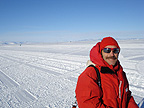November 06, 2007
Ishman joins elite scientific team in Antarctica

Caption follows story
Scott E. Ishman, associate professor of geology in the College of Science at SIUC, is making his eighth trip to Antarctica, where he hopes to discover secrets of the Earth's past as a member of an elite international team. Ishman is working with ANDRILL, an international group of more than 150 scientists that investigates Antarctica's role in global environmental change.
NBC television is scheduled to feature the ANDRILL team on its Nightly News program this week, perhaps as soon as tonight (Tuesday, Nov. 6).
Ishman has a long history with the frozen continent, first visiting the frigid landscape as a graduate student. Following a more recent trip, Ishman's co-authored an article arguing global warming is a recent, human-made phenomenon. Also, in 2004, he joined a team that discovered an undersea volcano in the Antarctic Sound.
Ishman is now with a team made up of about five dozen scientists, engineers, technicians, students and eight teachers from several countries. Its mission is recovering rock cores and sediment using a sea-ice platform adjacent to the Ross Ice Shelf in the Southern McMurdo Sound.
The science team is based at McMurdo Station, a U.S. research base on Ross Island. Ishman and others work in a laboratory examining samples — delivered about 10 p.m. each day — for clues to the Earth's climatic past.
Ishman is one of five micropaleontologists on the team working on the ice that is looking at foraminifera, a tiny single-cell organism that lives in the ocean and has a shell.
"By looking at the shells that are preserved as fossils in the rock cores we are recovering from the drilling, I help provide information on the age of the rock and what type of environment it was formed in," Ishman said. "With the information I provide, and that of the others in the paleontology group and sedimentology group, we are deciphering the climate history of Antarctica for the last 17 million years.
"We hope to drill at least 1,000 meters of core before we are finished," he said. The team is scheduled to be on site until January.
ANDRILL tapped Ishman last year for the Antarctic Drilling Program, a multinational scientific research effort aimed at recovering core samples from the sea floors around the region. While "on-ice," Ishman and his colleagues will endure one of the harshest, driest environments on Earth. Even during the so-called "warm season," the air will drop to a bone-aching 15 below zero at night while hovering around 30 during the day.
Facts about ANDRILL:
ANDRILL is a multinational collaboration involving Germany, Italy, New Zealand and the United States. Funding support for ANDRILL comes from the U.S. National Science Foundation, Antarctica New Zealand, the National Program for Research in Antarctica, Italy; the German Science Foundation and the Alfred Wegener Institute for Polar and Marine Research Science, Germany.
The overall science themes for the ANDRILL Program are: (a) thresholds and stages in the development of the cryosphere; (b) climatic optima and ice sheet stability; (c) ice sheet modulation of global climate and sea level; (d) origins and adaptations of polar biota; and (e) West Antarctic Rift (WAR) and uplift of the Transantarctic Mountains (TAM).
Specific SMS objectives are outlined in the SMS Prospectus document (www.andrill.org/support)
Amount of science funding: national breakdown: U.S. $13 million; New Zealand $3 million; Italy $1.5 to $2 million; Germany $500,000. The total project including logistics has been internationally funded at $30 million.
The operator for the ANDRILL Program is Antarctica New Zealand.
Caption:
Frozen history – Southern Illinois University Carbondale scientist Scott E. Ishman, associate professor of geology, stands on the ice near the Ross Ice Shelf near McMurdo Station in Antarctica. Ishman is part of an elite international scientific team examining rock cores and sediment from the seabed for clues about the continent's role in the global climate.
Photo provided
